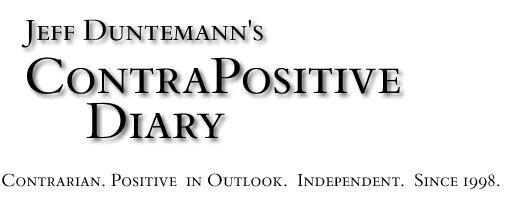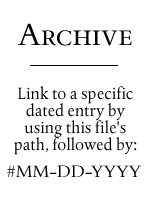|
|
|

|
 December
31, 2007: Rocketing on New Year's Eve December
31, 2007: Rocketing on New Year's Eve

Shortly before driving out here, Pete got in touch with the Colorado
Springs Rocket Society (COSROCS) and we got an invitation to
an impromptu lauch this morning out at the club's launch range waythehelloutthere
beyond Peyton, Colorado. The photo above gives a good impression
of the area. Is it just me, or does the image suggest an alien planet
on the edge of some star's habitable zone? (If the sun were at the
horizon it would look like the twilight band of Longshadow, the
tidally locked world in the Zeta Tucanae system on which some of
the action of The
Cunning Blood takes place.)
It was 22 degrees when we got there about 9:30 AM, with a good
stiff wind and some powder snow in the hollows. The club was testing
some newly built launch gear, so it was a small gathering, with
Pete and myself and just three other club members plus the owners
of the ranch on which the club's launches are held. Pete brought
along his newly completed (as of the night before) Estes Interceptor
E rocket, a 39" beauty into which he had poured many hours
over the past week or so. (I have one underway too, but we knew
we didn't have time to finish both of them before the launch this
morning.)

Pete had a couple of other rockets with him, and we fired them
all without losing any of them. His 15-year-old Phoenix model cracked
the glue joint on one fin as it touched down a little awkwardly,
but it's nothing that a little 90-second epoxy won't cure.

The photo above shows the Interceptor E on the launch rod ready
to go. We got some terrific video of the launch and recovery, but
the .mov file is 53 MB huge and I don't have the server bandwidth
to make it a download. (We may post it on YouTube after Pete does
some video editing on it.)
The wind was intermittent, but when it was blowing it was blowing
hard enough to be a hazard. One of the other club members put an
E-class engine in his rocket and may have hit 1,000 feet, after
which the wind took the vehicle a long, long way. He jumped in his
truck for the chase, and through binoculars we watched him scour
a field across the road more than half a mile off.
We got about a dozen launches in before pausing for some hot chocolate
and homemade cookies with Tom and Eileen Preble, our very gracious
hosts. Tom is that kind of guy you'd like to have behind the same
tree as you; in addition to being an amateur astronomer and a private
pilot, he built his passive solar house with his own hands. It was
a toasty 72 degrees inside even though the nightly lows had been
touching zero and they hadn't had the heat on in three days.
Pete and I drove back to Colorado Springs marveling at how well
it had all gone. I realized once I got out of the car again that
after being fired, model rockets carry the unnmistakable whiff of
black powder. (I myself hadn't fired a model rocket in thirty years
and had completely forgotten...) The car is in the garage with the
windows open, and I'm considering a gasket case for toting future
vehicles to and from the launch range. You live and learn.

|
 December
28, 2007: Is It Singularity Yet? December
28, 2007: Is It Singularity Yet?
Every once in a while, I look around to see if the Singularity
guys are still out there making noise, and shucky darns, they still
are. I won't recap the whole Singularity thing, nor my primary objections;
see my entry for August
28, 2004. But every couple of years, I feel obliged to demand
that the Extropian crowd give us some examples of exponential progress.
Computing? Hah. We're adding cores to CPUs without any idea how
to use them. We have no idea how human intelligence works conceptually.
(If we did we could emulate it. We can't.) We have no idea how the
brain works. (So much for uploading it to a computer.) We are barely
on the threshold of some real understanding of cellular processes.
We have been using the Space Shuttle for 30 years, and are about
to go back to a spacecraft that is basically the 45-year-old Apollo,
with some marginal improvements. We can't perfect a scramjet to
save our lives, nor a fully reusable SSTO launch system. A Drexler-style
nanoassembler is nowhere in sight. (It may take another hundred
years, and will require an almost complete understanding of those
elusive cellular processes.) We have not extended lifespans, though
we have improved the quality of life to some extent in the years
40-70. I've read in several places that the drug companies are hard-pressed
to come up with new miracle drugs. Commercial fusion energy is still
the same 25 years away that it was in 1970.
Guys, show me any evidence at all of exponential progress.
I will ask the question again in another three years. In the meantime,
I'm wise to you, and life in 2007 still looks a lot more like life
in 1950 than life in 1950 looked like life in 1900. This is not
an exponential curve, and if you think it is, we need to talk a
little about what "exponential" means.

|
 December
26, 2007: Odd Lots December
26, 2007: Odd Lots

- Christmas is now officially over for most of the world—especially
the commercial part of the world, for which it ended about noon
yesterday—but over here we celebrate Christmas for a considerable
while longer, generally until January 6. Our tree has stopped
taking up water, so it may need to come down sooner than that,
but our hard-won Lionel layout will remain at least that long,
and we have pfeffernuss
cookies, bourbon
egg nog, and other goodies that may last longer still. (I
don't wolf down cookies like I used to, and a little bourbon goes
a long, long way with me.)
- There is another nuclear waste car in the Lionel canon: The
6805 Atomic Waste Disposal Car (see above) which was sold in 1958-59,
and worked with a small crane that I haven't found a good photo
of yet. The little containers had red lights inside them, and
when the batteries were fresh would glow ominously as they spun
around the Christmas tree.
- Among the many gifts that Carol gave me yesterday, the best
is probably a
shredder that shreds CDs and credit cards as well as paper.
I have a stack of old backup CDs awaiting proper destruction,
and the device will be most useful.
- If you haven't already read it, I recommend Frederick
Forsyth's The Shepherd, especially if you're into military
aviation. Pete Albrecht gave me a copy for Christmas two years
ago, and you can read it in an hour. I had not heard of the odd
De
Havilland Vampire fighter/bomber before reading it, and I
now have a very good feel for what a fighter pilot's lot was like
in peacetime 1957. It's a Christmas novella that some call a ghost
story, but that's not quite fair; some heroes just don't allow
little things like death to get in the way of their missions.
- Wired has an
intriguing article about the effects of high-tech gadgetry
on the housing market. Demand for existing (and especially older)
houses is down in part because people really want home theater
rooms and CAT5E in all the walls.
- If one of you Linux gurus could recommend a hard drive cloning
utility running under Linux that would allow me to make a bit-copy
of a hard drive (including the MBR) to a second blank drive, I
would appreciate it, especially if it's free software.

|
 December
25, 2007: Faith and Action December
25, 2007: Faith and Action
Christmas Day. Somewhere between those who cannot abide religion
and those who cannot live without it is a group that doesn't get
much press: Those who sense transcendence and are drawn to it, but
who cannot frame a rational response to the impulse. "I'd love
to have faith in God but I don't know how to do it!" is how
one person put the problem to me. Others have freely admitted that
they don't know what faith is or how it happens within a person.
Is faith inborn? Can faith be learned? What are faith's limits?
I know how they feel. I've struggled with the issue of faith for
my entire life, and much of that struggle was and remains pure torment.
I don't know for sure if faith can be learned—to be honest,
it seems to be something you're born with in some measure, all of
us scattered across a bell curve on the faith scale, as we are for
so many other things. I think, however, that I can define faith,
at least as it works for me: Faith is taking something seriously
enough to act appropriately.
Taking something seriously is the core of faith. If you're in the
outfield and you believe that you have a chance of catching a pop
fly ball, you'll start calculating its trajectory and moving toward
it. If you don't take the game seriously—or if you don't take
your own ability seriously—you may just let someone else run
for it. If you believe that an upcoming exam is going to be tough
but unavoidable, you'll cracks the books and do what you can to
improve your score. If you don't take the exam seriously, you may
just blow it off.
Saying, "I believe in God" doesn't mean much unless it
changes the way you act. What changes those might be will vary with
your culture and the way you think about God. It's possible to be
interested in the divine as a concept, and in religion as a fascinating
thread flowing down through human history, but if you don't somehow
convert that interest into a system of guidelines for everyday action,
it's just an interest without any least hint of faith.
The flipside may be true as well. I find it fascinating that there
are a great many people who will state flatly that they don't believe
in God at all, but who nonetheless act in accordance with the universal
principles espoused by all the major religions: Be honest, be truthful,
be faithful to your spouse, do not engage in cruelty; and in general
do unto others as you would have them do unto you. They would claim
that they have no faith at all, but virtue is a decision,
and whether or not we can fully explain how we came to that decision
matters much less than simply getting there. Taking virtue seriously
enough to be virtuous may not be religion, but it is definitely
a sign of faith—and if I were God, I think I'd grin and say,
"Mission accomplished."
There's much more to the issue of faith than that, but I'll let
it rest for now. Carol and I wish you and your loved ones all the
best in this Christmas season. Thanks for reading, thanks for your
comments, and above all thanks for your friendship. Friendship is
the best clue I've ever found indicating that God is real and at
work in the world. Have friends. Take them seriously. All the rest
will follow from that!

|
 December
23, 2007: My Lionel Nuclear Waste Car December
23, 2007: My Lionel Nuclear Waste Car

Pete Albrecht drove out from Costa Mesa to spend Christmas with
us, as he did two years ago, and of course when he's here we grant
ourselves permission to be 14-year-olds again, at least with respect
to toys. Our first stop was (as last time) Custom Railway Supply
on Garden of the Gods Road, to pick up some Lionel track sections
for this year's layout around the Christmas tree in the great room.
On their used equipment shelf I spotted an interesting piece of
rolling stock: a Lionel 6515-4 Reactor Fluid Transport Car, complete
with an imaginary AEC insignia and the slightly puzzling legend,
"When empty please return to the disposal site." Nonetheless,
having been a highly contrarian fan of nuclear power for forty years
now (since before ignorant condemnations of nuclear energy became
a lefty fetish, in fact) it was an item I just had to have.
The car is interesting in a lot of ways. The tank is made of transparent
plastic, and contains a weird-looking purple-black pearlescent liquid
that probably matches what most preteen boys hold as an image of
radioactive waste. There's even a ball bearing rattling around inside
it, to stir up whatever makes the fluid pearlescent again after
the car sits in a box for a year between Christmases. (I'm guessing
aluminum dust.) The trucks have working springs.
After we put up our first shot at a layout, Pete and I celebrated
nuclear power by putting my new nuclear tank car in the middle of
a Pennsylvania Railroad passenger consist and running it around
the tree for half an hour, shunting it onto a siding periodically
to calm down all the hysterical imaginary passengers, who had booked
on in Philadelphia for an anti-nuclear protest in San Fran. Half-past
Wyoming we told them to love nuclear or walk home in the dark.
Maybe we had had a few too many Pfeffernuss cookies; we didn't
get into the spiked egg nog until later that evening. Pete brought
out a lot of German goodies, and my sugar intake since Thursday
is now rivaling what I generally allow myself over the course of
an entire year. We're going to make German potato pancakes Christmas
Day, and salmon in cream sauce the day after (or thereabouts.) Our
next project is to build a couple of Estes model rockets and see
if we can launch them somewhere without having to ask permission
of the local paranoids. (That would be the police department, not
NORAD, which actually knows something about rockets, heh.)
So our very contrarian Christmas here is going precisely as planned.
Carol is washing Aero, there's snow on Cheyenne Mountain, and God
made Uranium too. All is well.

|
 December
20, 2007: Carl, Jerry, and a Primordial Girl-Geek December
20, 2007: Carl, Jerry, and a Primordial Girl-Geek
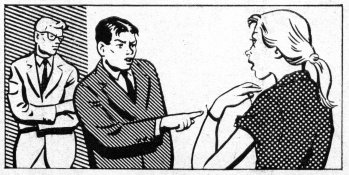 I
just turned loose another
Carl and Jerry free story, this one of particular interest,
because one of Jerry's nearly always infallible techie plots is
foiled—by his girl-geek cousin Pat! Considering that the story
originally appeared in December 1958, this is remarkable. John T.
Frye was a man of his era, but he respected ability and education
far more than he respected the social conventions of his time. Female
electronics enthusiasts were very uncommon in 1958, but they existed,
as evidenced by some of the ham radio "YLs"—Young
Ladies, of whatever age—who built their own rigs from loose
parts and worked the world with them. I
just turned loose another
Carl and Jerry free story, this one of particular interest,
because one of Jerry's nearly always infallible techie plots is
foiled—by his girl-geek cousin Pat! Considering that the story
originally appeared in December 1958, this is remarkable. John T.
Frye was a man of his era, but he respected ability and education
far more than he respected the social conventions of his time. Female
electronics enthusiasts were very uncommon in 1958, but they existed,
as evidenced by some of the ham radio "YLs"—Young
Ladies, of whatever age—who built their own rigs from loose
parts and worked the world with them.
The story is a hoot, and it's one of the reasons I'm glad I've
put as much time into the series as I have. I had never read "Under
the Mistletoe" before I began the Carl & Jerry project,
because I never had any issues of Popular Electronics that
old. Now that I've read them all (some of them many times while
searching of typos) it's become clear that Frye had a much better
opinion of women than most male engineers had in the Fifties. In
later issues, once the boys went off to Parvoo University (a very
thin disguise for Purdue) they quickly found engineering student
girlfriends who somehow managed to master electronics without completely
abandoning the 1950s image of young women. Mainstream SF was only
beginning to appreciate women as equals of men in that era, but
for Frye, it was just part of his unwavering conviction that if
you know the tech, you're in the club, and nothing much else mattered.

|
 December
19, 2007: Confessions of a Middle-Aged Mall Rat December
19, 2007: Confessions of a Middle-Aged Mall Rat
Whew. Some observations after a very long day trying to finish
up my Christmas shopping, during which I hit not one mall but two,
as well as numerous sites along the interminable commercial strip
down the full length of Academy Boulevard:
- From the Who's Twisting That Poor Cat's Tail Dept: Saxaphone
jazz covers of Christmas carols do not sound like Christmas.
Nor do they sound like jazz.
- From the Carol and I Made the Right Decision Dept: Above the
racket at the center of Chapel Hills Mall comes the plaintive
cry at the very top of his four-year-old lungs: "Mommy, I
have to PEEEEEEEEEEEEEE!"
- From the Some Things Man Was Not Meant to Know Dept: While trucking
past Intimate Apparel in Dillard's (unless it was Macy's) I noticed
a sign reading SALE ON SPECIALTY BRAS. Specialty? Are there Utility
Bras? Ok, all right. Sorry I asked.
- From the Know Your Product Line...Please Dept: At Barnes
& Noble at Chapel Hills, I was scanning the computer book
shelves (at least it's still plural) when a sales associate whisked
her way behind me, leading a confused-looking geek behind her.
They stopped at the next case and she began furiously scanning
titles, mumbling "Schneier, Schneier, Schneier...he's here
somewhere..." Thirty seconds later she had still not found
Applied Cryptography, so I leaned over silently and tapped
my finger on the brilliant red spine. "Oh," she said,
and handed the book to the waiting geek, who shook his head as
she roared off again. "If you're buying that, buy Secrets
and Lies too," I said. "You won't regret it."
He did. And he won't.
- From the Earth is Not What It Used to Be Dept: Carol and I are
shopping for globes. Woodley's Furniture had ten or twelve different
models, but every single one was made of this faux mother-of-pearl
crap, with a crudely shaped piece for each country. I complained
about this to the smiling sales rep, who said, "Oh, well,
you understand that we really sell them as accessories..."
Postscript: All the gimbaled globes were top-heavy, with Antarctica
facing up. Set them right with the North Pole up and they slowly
sink back again.
- From the Frostbite Falls Fashion Flair Dept: Down at Citadel
Mall, a gaggle of four junior-high girls, all in big bulky winter
coats (some including fur-lined hoods) walked past barefoot,
carrying their flip-flops in their hands. It was 38 degrees outside.
- From the No Steampunk Toys in My Stocking This Year Dept: Sunbird
Train Mart had the Marklin G Scale model of the Kruckenberg
Rail Zeppelin on display. (Scroll down.) You can have one
too—for only $1199. Back in 1931, this amazing gizmo (basically,
an Art Deco railcar driven by a huge pusher propeller) managed
to roar along at 230 km/hr (about 160 miles/hr) for 20 km, a land
speed record that stood for over 20 years. Gearing a piston engine
to deliver torque to wheels across a speed range from 0 to 160
mph is difficult, and placing a prop right on the drive shaft
is a distinct advantage. Sucking waiting passengers off the platform
and chopping them into dog chow is a disadvantage, however. (This
didn't happen; still, the public has a vivid imagination, and
the Schienenzeppelin
never went into production—made unnecessary by the development
of a more conventional railcar called the, um, Flying
Hamburger.)

Shop until you drop? Done, done.

|
 December
17, 2007: This Gentleman Prefers Pages December
17, 2007: This Gentleman Prefers Pages
A little-noted but absolutely crucial divide in the ebook world
hinges on the question of whether book pages—numbered sequential
blocks of text with a fixed format—are necessary, or even useful.
I've been mulling this ever since I first loaded a Web page in late
1993 and watched it reflow text as I dragged the lower-right corner
of the browser window around. Reflowing text stuck in my craw, in
part because I was a magazine editor at that time, and magazine
pages have very definite layouts.
I've flip-flopped on the issue many times over the years, but I've
recently come back to my original position: The page is essential.
Ebooks need page structure so that we have a universal, human-readable
notation for identifying a location in a large document. This location
must apply identically to all editions of the same work, whether
print or electronic. If the equation is on page 201 of a print book,
it should be on page 201 of the ebook. This requires that the ebook
have a page 201, and in a lot of modern ebook reader software,
page numbers are dependent on font size, meaning that they're basically
meaningless.
The argument that text needs to be displayable on many different
shapes and sizes of displays always seemed like a non-sequitur to
me. Laying out a book into pages does not preclude reflowing
the text in a window. I know enough about PDF internals to say
with some confidence that a properly designed PDF viewer could render
a PDF as reflowable text with page boundaries shown by a dotted
line. All the information is there in the PDF; it's up to the viewer
how the text is presented to the user.
So all the seething arguments about page-oriented versus reflowable
file formats is kind of ridiculous. It's not about the file format.
It's about the viewer. I see no reason why the industry could not
standardize on PDF documents and create special-purpose viewers
for devices with small or otherwise nonstandard displays. Certainly,
as a publisher I'd prefer to create just one single file format
for a published work, supporting both print and electronic editions,
and let the viewer software adapt to the limitations of the underlying
hardware.
Right now, ebooks are mostly fiction and purely textual nonfiction
because our low-power portable displays aren't good enough to render
complicated page images well. That's a temporary limitation. I think
that within five to eight years we'll see letter-size tablets with
full-color, 1200 DPI electrophoretic displays that can render a
page image pretty much as well as paper. This will allow ebook editions
of comics, kids' books, art books, and figure-intensive technical
books without any compromise, and if you want to go crosseyed reading
something like that on your cellphone, well, it's up to your software.
Page images are the baseline. Subset the format however you prefer,
and we'll all get what we want.

|
 December
15, 2007: Odd Lots December
15, 2007: Odd Lots
- Whew. I just got the last of the Christmas cards mailed, and
posted our Christmas letter PDF here.
- I was testing a promising open-source media player app called
Miro today, and it's one
of the very few Win32 apps that has bugs under Windows 2000 that
don't appear under Windows XP. It can't find its own icon under
Win2K, and suffers random freezeups. On the other hand, it works
fine under XP and plays every kind of media file I have without
a burp.
- Don't just cross yourself with holy water. Have
it over ice. (Thanks to Greg Singleton.)
- ASUS has begun shipping a
Pentium mobo with Linux on flash, along with a simplified
Firefox Web browser and the Skype VOIP client. Within five seconds
of turning the damned thing on, you can be surfing the Web and
talking to your uncle in Finland. Or boot on to Windows or a fuller
version of Linux. This is clearly the way we're going, and now,
guys, how about booting right into Xen? (Thanks to Andrew Stuart
for the heads-up.)
- Greg Singleton is also running a contest for the most garish
outdoor Christmas decorations in the country. Here's
one that's not three miles from where I grew up in Chicago.
That would be tough to beat, if for no better reason than they're
just about out of front lawn.
- You can get almost anything else through a USB port...how
about red wine? This, I'm told, is even funnier if you understand
French. (Many people sent me this; thanks, guys!)
- Mike Reith sends a pointer to as story about the
guy who invented the video tombstone (like the ones at the
end of Serenity) who, alas, has not yet sold a single one.
- What do I want for Christmas? How about a
lump of ytterbium? All I need now is a 2 megacore yottaflop
distributed processor and I could build a Hilbert stardrive!

|
 December
14, 2007: A Christmas Playlist December
14, 2007: A Christmas Playlist
By sheer coincidence, I was asked a few days ago what sort of Christmas
music I was listening to this year, just as I was massaging a playlist
together for a mix disc I made for myself a few weeks back. So here
it is: 23 Christmas songs from my personal Christmas music collection,
which consists of about thirty CDs and ten or fifteen vinyl LPs.
Most of this music can be purchased from Amazon or eBay as whole
CDs; whether you can get it from the online music services is unclear.
(I don't use them.) The "Great Songs of Christmas" vinyl
LPs were remarkable anthologies given away by Goodyear dealers when
you bought tires in the fall. The ones I have are the ones we got
in the early 60s, but they were an annual thing from 1961 right
into the early 70s. Firestone got into the same business a few years
after Goodyear (and I have a couple of those) but they are nowhere
near as good. Abundant and cheap on eBay, assuming you still have
the hardware to play vinyl!
All of this will fit on a single 80-minute CD-R. Let me know if
you find playlists like this useful. I have others.
Carol of the Bells
Windham Hill Artists
My all-time favorite Christmas carol, performed here as the main
melody alternating with variations on the melody, by several of
Windham Hill's artists, including Liz Story, Andy Narell, Barbara
Higbie, and Paul McCandless. From: A Winter's Solstice IV
Sing Hosanna, Alleuia
The New Christy Minstrels
Great hootenanny folker from some of the best voices and best
harmonists of the past fifty years, best appreciated by those
who were there when hootenanny folkers were first-run.
From: Great Songs of Christmas, #4. (1964 Vinyl)
Christmas in Killarney
Bing Crosby
I'm a thoroughgoing American mongrel, but there's enough Irish
in me to appreciate this canonical performance from the soundtrack
of White Christmas. Although corny and seriously bass-deprived,
it was much beloved of my very South Side Irish grandmother Sade
Genevieve Prendergast Duntemann (1892-1965) and I include it here
in her memory.
From: White Christmas (Bing Crosby)
The Holly and the
Ivy
Alex Di Grassi
A sprightly version of the ancient hymn, without the words (which
no one really understands anymore) to slow it down.
From: A Winter's Solstice V
I Heard the Bells
on Christmas Day
Ed Ames
Perhaps the single most powerful Christmas lyric ever written,
culminating in that magnificent affirmation: "God is not dead
nor doth He sleep." As a friend of mine once more crudely
put it: "That's the kind of song that makes the Devil crap his
pants every time he hears it."
From: Christmas with Ed Ames (1967 vinyl)
We Need a Little
Christmas
The New Christy Minstrels
A superb Christmas song from a musical (Mame) that had
nothing to do with Christmas!
From: Great Songs of Christmas #3 (1963 Vinyl)
In the Bleak Midwinter
First Call
This obscure carol has in recent years come to be my second favorite,
with its melody ("Cranham") by Gustav Holst and words
by his friend Christina Rosetti. Good close harmony here. It never
fails to bring a tear to my eye. What indeed could I possibly
give back to God? Somehow computer books just don't seem to cut
it.
From: Beyond December (First Call)
The Man From Caesaria
Friedemann
An arrangement of an ancient and slightly spooky Greek hymn attributed
to St. Basil. The Orthodox are Catholics too, and for me this
song sacramentally represents their concept of the Great Journey
of Theosis, back to unity and wholeness in the Presence of God,
where I believe against all denial that everyone and everything
will eventually arrive.
From: Narada Christmas Collection
Logs to Burn
Golden Bough
Did you know that holly wood burns like melting wax? Or that cherry
wood will scent the room? This is a wood heat user guide that
you can sing over a cup of mulled wine. Damned clever, those English.
From: Winter's Dance (Golden Bough)
Christmas Eve
Ira Stein
I don't know
why, but this piece (which has no words) suggests for me the watch
that little kids of Polish heritage keep for the First Star on
Christmas Eve (as my sister and I did) when Vigilia begins, and
beyond that all good things that are worth waiting for, no matter
how much the waiting makes us ache.
From: Narada Christmas Collection 2
It Came Upon a
Midnight Clear
The King's Singers
A choral version of perhaps my third-favorite Christmas carol,
with rich harmony of a slightly odd sort, which is the trademark
of this excellent group.
From: A Little Christmas Music (King's Singers)
Il Est Ne and Immaculate
Mary
Liz Story
"He Is Born" (French) in a piano medley with the Mary song we
sang maybe a little too much back at Immaculate Conception grade
school, especially in May. An odd combo, but it works.
From: The Gift (Liz Story)
Traditions of Christmas
Mannheim Steamroller
Chip Davis decided he wanted to write a classic Christmas carol.
I wish I could pull off everything I try as well as he did.
From: A Fresh Aire Christmas (Mannheim Steamroller)
Patapan and Noel
Nouvelet
Nancy Rumbel
Two old French hymns done by a superb flutist in a medieval style.
From: Narada Christmas Collection
Song of the Evergreen
Kostia
If Christmas trees had a national anthem, this would be it. Makes
me want to stand up and cheer when it's over. (Or maybe yell,
"Play Snowball!")
From: Narada Christmas Collection 2
Joseph Dearest,
Joseph Mine
Simon Wynberg
The slightly dumb lyrics are omitted, leaving a nice old melody
about perhaps the least appreciated saint of all. "Stone my wife?"
this muscular man asks the Pharisees, with pockets full of awls
and chisels, a mallet in one hand and a razor-sharp saw in the
other. "Just try it."
From: Narada Christmas Collection 2
It Came Upon a Midnight
Clear
Wayne Gratz
The piano stars in this superb instrumental rendition of my third-favorite
carol, with only a little occasional violin for backup. Deeply
moving.
From: The Best of Narada Christmas
Three Candles
Schonherz & Scott
Again, it's hard to say just why, but this instrumental piece
sounds to me like an emblem of Hope, the most neglected of the
Cardinal Virtues. Don't just light one candle. Light 'em all—God
will give you as many as you need—and the light will never
go out.
From: A Winter's Solstice IV
Wizards in Winter
Trans-Siberian Orchestra
One unauthorized video of a house virtually dancing to this tune
probably sold more albums for these guys than anything their label
ever did for them. Although there are some hints of The Nutcracker
here, I see a gigantic Niagara steam locomotive pounding its way
heedlessly through a furious Rocky Mountain blizzard. You can't
stop a 4-8-4—not with something as simple as snow!
From: The Lost Christmas Eve (Trans-Siberian Orchestra)
And with that, I'll have to step up the pace on various Christmas
things here. See you in a few.

|
 December
11, 2007: The Pope and the Council December
11, 2007: The Pope and the Council
 People
regularly ask me, "How can you be a Catholic and be against
the Pope?" It's an odd question but an understandable one.
I am not against "the Pope," though I am very suspicious
of idealists like John Paul II. (Irrespective of his nickname "The
Grand Inquistor," I am much more at ease with pragmatist Benedict
XVI.) What I am against is the whole concept of a Papacy that has
evolved to give all authority within a global, billion-member church
to one man, with the clear implication (if not always explicit statement)
of infallibility. I am against the concept for a simple reason:
It is a single point of failure for the entire Roman Catholic
Church. People
regularly ask me, "How can you be a Catholic and be against
the Pope?" It's an odd question but an understandable one.
I am not against "the Pope," though I am very suspicious
of idealists like John Paul II. (Irrespective of his nickname "The
Grand Inquistor," I am much more at ease with pragmatist Benedict
XVI.) What I am against is the whole concept of a Papacy that has
evolved to give all authority within a global, billion-member church
to one man, with the clear implication (if not always explicit statement)
of infallibility. I am against the concept for a simple reason:
It is a single point of failure for the entire Roman Catholic
Church.
Read enough history of the Roman Catholic Church from non-Church
sources and you'll soon see what I mean. The early Church had a
distributed system of government based on overseers ("bishops")
in larger cities, who settled disputes by meeting periodically and
hashing them out as a group. What we call "the Papacy"
was originally nothing more than the office of the bishop supervising
the Church in the city of Rome, and was a very different creature
until well after the Roman Empire adopted Catholicism as its state
religion in 313. Several of the earliest Popes, in fact, may not
even exist; contemporary records are so poor that we may never really
know, and the lesson we can take from them is that the Bishop of
Rome was not considered anything special or different from any other
bishop in any other city of that time. Power corrupted the bishops
of Rome, who at first were considered (given Rome's status as the
center of the Empire) "first among equals" by other bishops
but not in any position of authority over them. The downward spiral
of the Papacy through corruption and ultimately into chaos continued,
hitting a low point around 1410, when there were three different
people claiming to be Pope, all of them scoundrels who would probably
be doing life terms if they lived today. (One of them was in fact
a highwayman/pirate who was said not even to have believed in God.)
We no longer elect pirates to the Papacy, but we have not reversed
the sad situation that the Church is now an appendage of the Pope,
and bad decisions made by one man without consultation can seriously
alter the Catholic Faith.
How this happened is a fiendishly complex and interesting (if perhaps
depressing) business, and it took a lot of reading to get the whole
story from enough different viewpoints to feel like I had something
like objective history in hand. Several of the secular histories
that I've read are decidedly polemic; as interesting as De Rosa's
Vicars of Christ may be, its author is clearly grinding an
axe the size of Sardinia. Chamberlin's The Bad Popes is better
and much more objective, but is more biography than history, and
does not speak in detail of the evolution of the institution of
the papacy itself. I didn't find a book that really answered my
questions until I bought a copy of The Pope and the Council,
published in 1869, just before the opening of the First Vatican
Council. Pope Pius IX had made no secret of the fact that he intended
to declare Papal Infallibility an article of faith. Two Roman Catholic
theologians wrote and pseudonymously published (as "Janus")
a long and heavily footnoted argument against Papal Infallibility
and the general assumption by the Papal office of absolute authority
not only over spiritual matters but also matters of secular government.
One of the authors was the very formidable Johann Joseph Ignaz von
Dollinger, who went on to lay the theological and eccelsiastical
foundations for the European Old Catholic Church, from his excommunication
in 1871 until his death in 1890.
I recommend the book to anyone who takes such things seriously,
but the book has been out of print since 1873, and when I bought
it (2001) copies were very uncommon and extremely expensive. More
copies are available online now, but you'll only rarely see one
for less than $50, and you'll generally pay $75 and up for something
that will leave crumblies in your hands as you read it and not survive
a great deal of thumbing. So I did the obvious: I scanned my copy,
OCRed the text, laid it out again, and am offering it on Lulu for
$21.95.
Note well: This is not an easy read. It was written by scholars
for scholars, and was translated from the German on a very tight
schedule. You may have to be clergy or a church geek like me to
truly appreciate it. However, if you really want to know why I cannot
accept Papal Infallibility, this is my answer. Buy
it here. Softcover, 330 pages. $21.95.

|
 December
8, 2007: Odd Lots December
8, 2007: Odd Lots
- Many have asked which book I have from Dr. J. Allen Hynek's
personal library (see yesterday's entry)
and with only a little trepidation I'll admit that it's A. R.
G. Owen's Can We Explain the Poltergeist? Hynek was interested
in a lot of odd things, clearly—just like me, heh.
- People have also asked me, given that I have a cow skull and
a horse vertebra on my office bookshelves, what else do
I have there? Alas, nothing quite as exotic as that—except
for a radio-controlled rat. If you want a list I'll give you one,
but you may be disappointed. (The bones have a story that I may
tell, however.)
- And alas, I have evidently misunderstood the "Ten Things..."
meme (see my entry for December 7, 2007) as three of them are
about other people—Irwin Scollar and my parents. They have
to be about me. So I've been asked for three more. Gotta think
some but if I can find three more I'll post them here somewhere.
- You can download a
VMWare Appliance that—mostly—emulates the OLPC XO.
I had it running within a minute of getting it downloaded, but
as with any custom hardware that differs significantly from a
standard PC, some of its features work differently or not at all.
- The OLPC XO has apparently scared Microsoft enough to prompt
them to offer
Windows XP for $3—assuming the machine's hardware is
jiggered to run it—and Negroponte is predictably having none
of it. Bravo. We need an adult version of Sugar for the XO, not
a crippled version of Windows. (We also need other things. Future
entry.)
- There are a number of other "sub-sub notebooks" that
the press has been positioning as competitors of the XO, including
the
Classmate from Intel and the EEE
PC from Asus, but none of them has a convertible display.
In other words, they are clamshells only. That's not the same
species of machine. In my view, to be an acceptable ebook reader,
a clamshell has to pivot into a tablet.
- It
is possible to have less than 5% of the brain tissue of a "normal"
human being and still have an IQ greater than 100. The article
is a quick summary, and while still controversial, John Lorber's
research is not nutcase stuff and suggests that we know even less
about the brain than we claim to. (The question thus re-emerges
from its box, as hard as Carl
Sagan's ghost tries to sit on the box and keep it closed:
Are we computers or terminals?)
- I f you don't mind a little occasional raunch in your Web comics,
this one also contains a lot of
geek culture and a certain amount of math humor. It also proves
Michael Abrash's point that comics are about writing, not drawing—lending
further creedence to my own contention that everything
is about writing. Some of the comics work better than others,
but yeek! This strip hits me
where I live. (Thanks to Pete Albrecht for pointing it out.)
- This
remarkable underground complex was dug in secret. Where the
hell did they put all that dirt and broken rock?
- There is a word for "cutting
large figures of horses into hillsides with spades."
The word is "leucippotomy." Damn, there's a word for
everything.
- By the way, an interesting way to kill some time with Google
Earth is to search for Britain's hillside chalk figures by eye,
beginning with the town they're near. (See the above point.) Those
things are indeed big.

|
 December
7, 2007: The Ten Things Meme December
7, 2007: The Ten Things Meme
My good sister
challenged me to do the Ten Things You Don't Know About Me meme,
and it really is a challenge. I'm such a damned blabbermouth in
my writing (and have been so for such a long time) that I'm not
sure that there are ten things that none of my readers know
about me that are worth knowing at all. I will try. And I'm asking
this of my readership: If you did in fact know any of these ten
things (be honest now) write and let me know: (Gretchen, you don't
count!)
- I am allergic to the sap of balsam pines. Not life-threateningly
so, but I get a rash when I touch them.
- I have a book in my library that once belonged to J. Allen Hynek
and is autographed by him.
- One of my friends (Prof. Irwin Scollar) was mentioned in a Carl
and Jerry story in 1964.
- My mother worked in ceramics.
- There is a cow skull on the high shelf here above my reference
titles, wearing my Lane Tech mortarboard and tassel, along with
the Chicago City Science Fair medal I won in 1970. On the shelf
below the skull is a vertebra from a horse.
- The doctor who gave me all my childhood polio shots and other
vaccinations (and they were legion!) was Dr. Pierce.
- My father had a pet alligator when he was in high school, and
it ate the neighbor's cat.
- I had only three wisdom teeth. (And no mathematical ability
teeth!)
- I was baptised twice.
- I have the ashes of three dogs (each in his own little plastic
box) in our breakfront, right under the good china.
I'm aware that we're into extreme trivia territory here,
and so for me the meme really isn't that much fun. I know that a
couple of my readers may know a couple of these things (Pete, that's
you!) but I'm betting that no single person beyond my family knows
more than three.

|
 December
6, 2007: His Silly Material December
6, 2007: His Silly Material
The film version of The Golden Compass opens tomorrow, and
people have been asking me what I think of all the frothing over
Phillip Pullman's anti-religion polemic. I read the books a couple
of years ago; I also know a little bit about the history of Christianity.
So let me respond here:
- Pullman is not specifically dealing with Roman Catholicism in
the stories, neither in the story's politics nor in its metaphysics.
The metaphysics are those of Gnostic Dualism, which teaches that
a very nasty and powerful—but hardly omnipotent—being
called the Demiurge created the physical world as a trap for spirits.
The Demiurge has helpers called archons that are basically
bad angels with names like Metatron.
Pullman calls his Demiurge the Authority, but the Authority is
not God as most people define Him. ("Killing God"—what
Pullman himself tells us the stories are about—is an absurdity.)
Gnostic dualism as a system of metaphysics was tossed out of Christianity
over a thousand years ago, though bits of it still stick to our
boots as Manichaeism.
- Close readers of Pullman's trilogy may remember that in Pullman's
alternate universe, the Protestant Reformers conquered the Roman
Catholic Church (instead of fighting it to a draw) and installed
John Calvin as Pope. Calvin was a tyrannical megalomaniac, called
(even during his own life) "the Pope of Geneva." Pullman's
Magisterium is a reasonable guess at what sort of church a psychopath
like Calvin would create, with the entire resources of the Roman
Catholic Church at his disposal. Pullman has thus created a weird
sort of fully imaginary Gnostic sacramental Calvinism as his heavy,
and there is so little of genuine Catholicism left in it (some
non-Catholic sects have nuns and bishops too) that the accusations
of anti-Catholic bigotry are pointless.
With that in mind, Pullman's anti-religion themes are misdirected
to the point of silliness. Railing against Christian Gnosticism
in 2007 is a lot like trying to organize a present-day protest rally
against the Eisenhower Administration—there wasn't a lot of
material there to begin with, and hey, it's been over for a long
time.
Pullman is a superb writer. The first two books were dazzlingly
well done as fantastic literature, and if you decide to read them
you should stop there: The third book, The Amber Spyglass,
was a total botch, and basically ruins everything the first two
books so carefully establish. Interestingly, it's The Amber Spyglass
where most of the polemic takes place. I wonder if Pullman got "anti-religion"
while working on the first two books and didn't fully express it
until the third, when he felt he could get away with it. If so,
it looks like the sort of self-indulgence trap that a lot of writers
fall into once they become successful.
Railing about religion is the least of it. What really troubles
me about His Dark Materials is that it is, in fact, so dark:
There is a grimness to the whole business and a casual disregard
for human life that was repellent enough to temper my early enthusiasm
for the concepts and the writing. The trilogy contains absolutely
no joy and nothing like triumph, and at the end of the third volume
a huge squirming mass of mismatched pain-soaked themes and metaphysical
loose ends descends into terminal incoherence. I wouldn't give it
to my own children, that's for sure—at least not until I was
absolutely sure that they understood that cynicism is
cowardice, and that they had the courage to make their own decisions
as to whether life is meaningful or not, rather than take some tenured
cynic's word for it.
I will probably see the film, even though the trailers seem dark
and muddy and singularly unimaginative. If that's the best they
can muster in terms of preview, I'm not sure that New Line Cinema
will make their $180M back. I'm also not sure that anybody can see
the CGI polar bears and not think of Coca Cola's mascots of several
years ago.
Maybe we're all getting a little tired of cinema fantasy and anthropomorphic
animals. (I certainly am.) We need another run of good starship
movies, but as best I know, there are none on the horizon. How about
Ringworld? Marooned in Realtime? Startide Rising?
Or Varley's flawed but startling Titan/Wizard/Demon?
Is there no escape from witches, magic, vampires, and stylish cynicism?
(So much for movies. I'm gonna go read a book.)

|
 December
5, 2007: Carl & Jerry Fanfic & Fan Art December
5, 2007: Carl & Jerry Fanfic & Fan Art
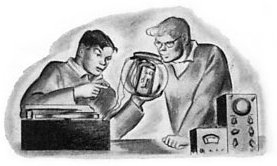 I
am hard at work on the fifth and final volume of Carl and Jerry:
Their Complete Adventures, and the last volume is a little different
from the first four, each of which contained at least 24 stories.
(The first volume contained partial year 1954, for a total of 27
stories.) John Frye did not write a story for every month in the
years 1963-1964. Those two years show only 20 stories, with the
last one appearing in November 1964. This leaves me a little extra
room in a 200-page book, and I want to try something: Carl and Jerry
fanfic. I've been asking around for new "classic" Carl
and Jerry tutorial stories, and I received one not long back from
George Ewing WA8WTE. I'm planning one myself, and I think there's
space for yet another one or even two. By "classic" I
mean a story written precisely as John Frye would have written it,
set in the early-mid 1960s, and limited to technology that was present
(if not necessarily uibiquitous) back then. I want the same characters,
the same settings, and the same general length, at least 2,000 but
no more than 3,000 words. If you're writer enough to do good pastiche,
stylistic similarity is also a plus. (This may be tougher than it
sounds.) I
am hard at work on the fifth and final volume of Carl and Jerry:
Their Complete Adventures, and the last volume is a little different
from the first four, each of which contained at least 24 stories.
(The first volume contained partial year 1954, for a total of 27
stories.) John Frye did not write a story for every month in the
years 1963-1964. Those two years show only 20 stories, with the
last one appearing in November 1964. This leaves me a little extra
room in a 200-page book, and I want to try something: Carl and Jerry
fanfic. I've been asking around for new "classic" Carl
and Jerry tutorial stories, and I received one not long back from
George Ewing WA8WTE. I'm planning one myself, and I think there's
space for yet another one or even two. By "classic" I
mean a story written precisely as John Frye would have written it,
set in the early-mid 1960s, and limited to technology that was present
(if not necessarily uibiquitous) back then. I want the same characters,
the same settings, and the same general length, at least 2,000 but
no more than 3,000 words. If you're writer enough to do good pastiche,
stylistic similarity is also a plus. (This may be tougher than it
sounds.)
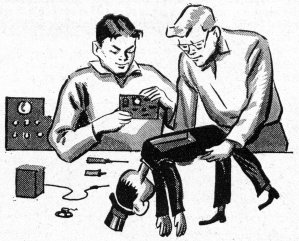 Above
all, the story must present some sort of tech concept in a way that
helps people understand how it works. People who followed Carl and
Jerry when they were first-run will know precisely what this means;
if you're much younger than I and unfamiliar with them, please download
and read some of the free stories (all PDFs in the 1.5 - 3 MB size
range) from my
Carl and Jerry page. Above
all, the story must present some sort of tech concept in a way that
helps people understand how it works. People who followed Carl and
Jerry when they were first-run will know precisely what this means;
if you're much younger than I and unfamiliar with them, please download
and read some of the free stories (all PDFs in the 1.5 - 3 MB size
range) from my
Carl and Jerry page.
This is a paying market, though it won't make you rich and I don't
think it will get you into SFWA. I'm buying first rights only, and
paying something somewhere south of $80; how much south depends
on how much work I have to put into it to make it publishable. Again,
we're talking a POD book with lifetime sales potential in the low
(or maybe mid) hundreds, so there's not a lot of money on
the table. It really is fanfic.
The new stories will need illos; again, done in a style that respects
the original period art without necessarily duplicating it. I don't
know how many artists I have in my readership (my stats tell me
I get 12,000 - 15,000 unique visitors per month, excluding LiveJournal,
so I hope there are some) but if you're interested, there are illos
in the free stories to give you a sense for what I mean. The artists
and art styles varied broadly over the series' 10 years; some of
the art is realistic, and some borders on cartoons. The approach
matters less than skill in execution. Again, I'm paying for the
art, but I'm not sure how much yet.
Contact me if you're interested.

|
 December
4, 2007: The Real Magic of OLPC December
4, 2007: The Real Magic of OLPC

When I first heard about One Laptop
Per Child I was dismissive—what third-world kids really
need are things like clean water and freedom from bloodthirsty governments—but
I've since changed my mind for several reasons. The best way to
reform autocratic societies is to educate their women, and the earlier
you start, the better. That's a whole separate topic, and not one
I feel like getting into right now or possibly ever.
No, the real magic of OLPC is the way its contributors have gone
back and re-thought much of what we assume about personal computing,
and in particular about portable computing. Latop computing is in
a bad place right now. My 2001-era Thinkpad X21 runs at 750 MHz.
My 2006-era Thinkpad X41 runs at 1.5 GHz—and seems to be only
half as fast. Ponderous file access, constantly stuttering mouse
pointer, poky screen refresh, well, what else should I say? (And
those were problems right out of the box!) My brother-in-law's hunky
new Vista laptop is twice as heavy, just as poky, and felt like
it would set my pants on fire.
It's time to throw it all out and challenge a few basic assumptions,
the first of which is that a portable machine must be capable of
doing anything a desktop can do. Nuts to that. The essence of portability
is size, weight, and battery life. Engineers should take that
as a given, and see what can be done with it. Don't start by assuming
Office 2007 or some massively animated video game as normative and
then shooting as high with the hardware as you can. That makes both
the hardware and the software look bad.
Laptops should not run Windows or OS/X. They should run an OS that
is tuned to do the most necessary things in an energy-efficient
way. This is the smartphone philosophy of design, used because there
is no choice—a smartphone can't sit there and continuously
slurp 25W from a battery the size of a CF card. Data compatibility
matters much more than software compatibility; that is, a portable
should be able to render and manipulate Office files but not necessarily
run Office itself. Much of our software is designed by people I
call "feature creeps" who (in fairness to them) are driven
as much by imperatives from corporate finance (and the tyrrany of
the "pip chart") as they are by any passion for creating
new things. They assume that next year's PC hardware will make up
for this year's cycle hogs, and for a long time that was true. It
hasn't been true for two or three years now, and that's why our
laptops seem so slow.
The brilliance of the OLPC
XO device is that its engineers literally went back to a blank
slate and started over. Gone is the bulky, heavy, fragile hard drive,
replaced by a tiny SDHC solid-state drive, plus an SDHC slot for
a second card. SDHC
cards hit 16GB this past fall, and I still use a Thinkpad X21
laptop that has only a single 20 GB hard drive—of which 6 GB
are still free. (I laid out a whole book on that machine!) The XO's
AMD Geode CPU runs at 433 MHz, which is actually fast enough to
do a lot of things if your OS isn't eating most of your cycles.
(My 2001-era Thinkpad X21 only runs at 750 MHz.) Its power-management
intelligence is radical. The Geode processor can turn huge chunks
of itself dead off when not needed, and so in monochrome ebook mode
(no backlight) the XO draws just half a watt. (In full functional
computer mode the XO draws about two watts, with about half of that
going to the backlit display.) The display spins around and allows
the device to work in either laptop mode or tablet mode. (Alas,
the first-gen XO does not have a touchscreen or stylus input. I
can only hope that future generations will.) The OS is a custom
fork of Fedora Linux optimized for both low-power operation and
kid-friendliness. It's not standard Linux, and that's a good thing.
Ubuntu is more efficient than Windows, but it's not efficient enough
to run on something constrained to 2 watts or less power consumption.
The XO went into mass production in November, and Third World governments
have begun ordering hundreds of thousands of them for use in rural
schools. Getting the cost down from $200 to $100 has been a problem,
but if they would just open the market up to First World consumers,
they'd be making them by the tens of millions and the cost would
plummet. Go figure. (Americans can currently by them only
by buying two, and sending one to a Third-World child.) Supposedly
the design is open-source, so if some other manufacturer wants to
make a version for the West, I'm guessing it's at least possible,
if not necessarily as cheap as the true OLPC device.
What I'm hoping is that the design will prove out that a laptop
doesn't have to run Vista to be useful. I'm especially fascinated
by the XO as an ebook reader. Even this early in its price curve
it's half the cost of a Kindle, and does a lot more. (You can program
it in Python!) So I'm watching it closely. I may even order one
under GOGO. If I do, I'll report here.

|
 December
1, 2007: The Three Species of Reading December
1, 2007: The Three Species of Reading
Sometime back, I realized, while soaking myself in the vigorous
online discussion raised by Amazon's Kindle, that there is more
than one kind of reading. "Reading" is not as simple
and monolithic as just sitting down with a book. In my view, there
are three different kinds of reading:
- Meditative reading is reading to change your state of
mind. "Reading for pleasure" is most of this, but there
are other kinds. People read to inspire themselves, to laugh,
or just to think of something other than what's going on around
them. I read dullish history books at the end of the day to make
myself sleepy. There is also the use of the written word as a
kind of spiritual mantra; in Christianity this is called
lectio divina, in which the act of reading itself,
independently of what is read, is treated as a kind of prayer.
- Autodidactive reading is reading to teach yourself something.
It requires deep attention, and for best results, the taking of
notes or outlines. This may involve reading entire books sequentially,
but in many cases it involves reading portions of several or many
books with some kind of topical relation. The overall goal is
understanding, skill-building, or decision support. Most tech
people read intensely to solve problems. It can certainly be fun,
but it can also be torment.
- Developmental reading is reading within the process of
creating texts for reading or presentation. It's what people in
publishing do, and I do it a lot. It includes developmental editing,
copy editing, proofreading, and indexing. It also includes the
sort of reading that supports writing, as of research papers,
documentation, or course materials.
Most people who now read ebooks regularly are meditative readers,
and most of that is reading for pleasure. We're starting to see
ebook use in autodidactive reading, but there's remarkable resistance
to the concept, even (or perhaps especially) in the tech industry.
Economic pressures eliminated printed manuals from software products,
and most tech people mourn that a little, perhaps because tech vendors,
for whatever reason, used to spend more effort on printed manuals
than they now do on online help. Also, the kind of extreme focus
that autodidactive reading often requires clashes with computer
displays. This is why I generally proof printed copies rather than
on-screen files, especially for book-length works.
What kind of reading we do bears heavily on what kind of ebook
reader we'd like to have, or whether we'd just as soon stick with
paper. If we're just reading to make the time go by, novels on a
PDA or cellphone display can work well. This is "one-dimensional"
reading; think of it as slurping text through a straw. Learning
from books is a lot more two-dimensional; for example, where there
are figures or photos in the text, or footnotes to read and perhaps
follow. Learning is often three-dimensional, by which I mean reading
that involves quick changes of focus from one book to another, with
occasional dashes to the Web. I sometimes sit in my chair with four
or five books lying face down on my nearby desk, the chair arms,
or the floor, like bugs. (When done on a bed, this creates something
called "the scholar's mistress," vividly portrayed by
Fritz Leiber in Our Lady of Darkness.)
There will come a day when the tech is good enough so that all
three kinds of reading can be done exclusively on electronic devices.
But I'm also pretty sure that a single device will not serve
all kinds of reading. This may explain a lot of the puzzlement
and indignant howling over readers, screens, and file formats. I
like my Sony Reader; it do make the time go by. But I have yet to
turn to it for autodidactive reading, even when the files are available.
Developmental reading is really computing, pure and simple, because
it involves so much data entry. The screen still makes my head hurt,
but I understand that I have no choice. (Yet.)
As displays get better and user interfaces mature and standardize,
things will improve. In the meantime, we need to understand that
not all readers serve all kinds of reading, and we need to think
a lot harder about what we are actually trying to do (and how we
go about doing it) each time we crack a book.

|
|
